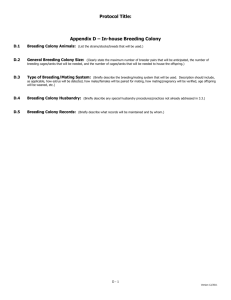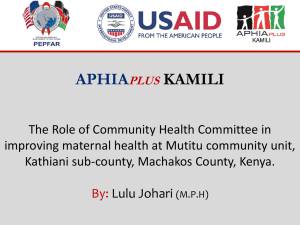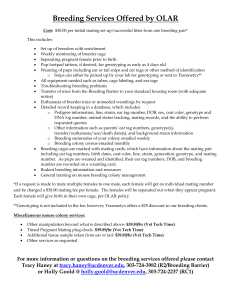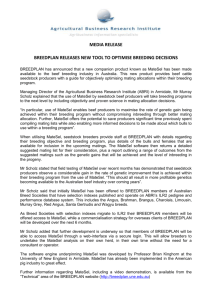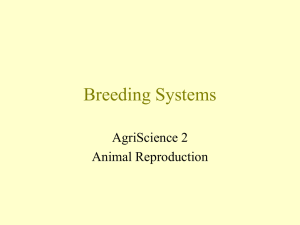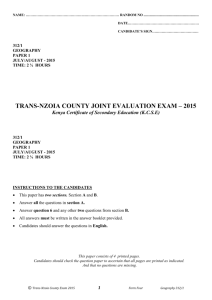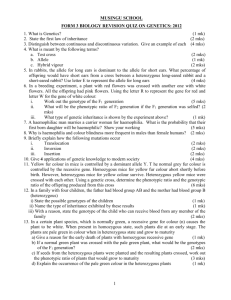HOMABAY SUB – COUNTY JOINT EVALUATION EXAM 2014 JULY
advertisement
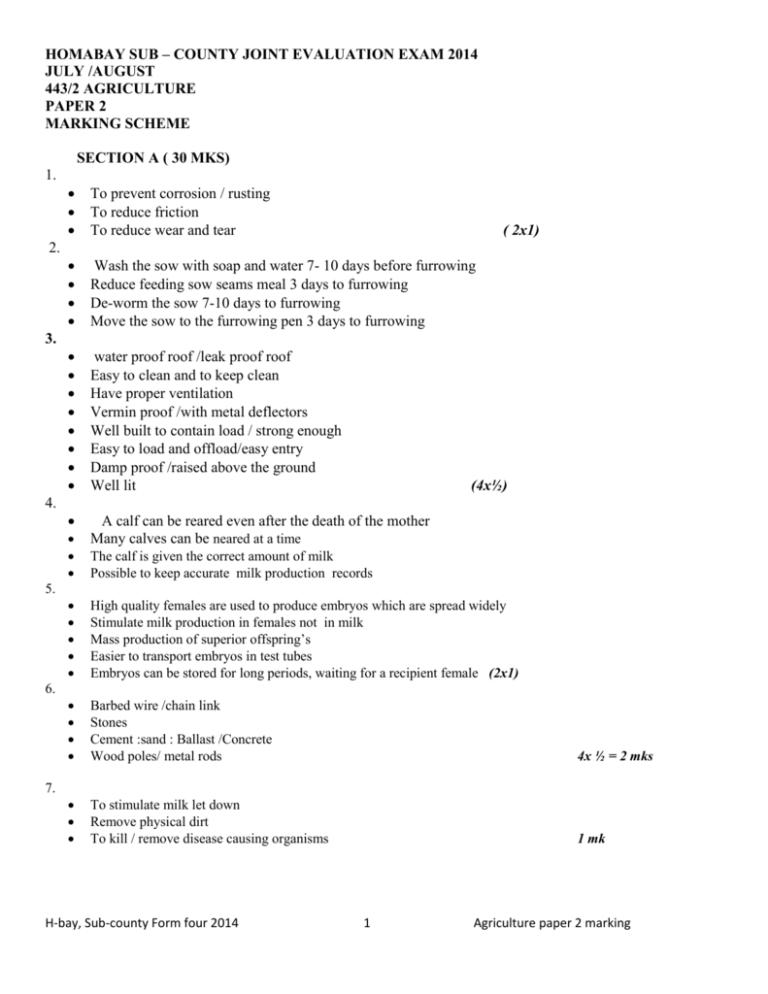
HOMABAY SUB – COUNTY JOINT EVALUATION EXAM 2014 JULY /AUGUST 443/2 AGRICULTURE PAPER 2 MARKING SCHEME SECTION A ( 30 MKS) 1. To prevent corrosion / rusting To reduce friction To reduce wear and tear Wash the sow with soap and water 7- 10 days before furrowing Reduce feeding sow seams meal 3 days to furrowing De-worm the sow 7-10 days to furrowing Move the sow to the furrowing pen 3 days to furrowing water proof roof /leak proof roof Easy to clean and to keep clean Have proper ventilation Vermin proof /with metal deflectors Well built to contain load / strong enough Easy to load and offload/easy entry Damp proof /raised above the ground Well lit A calf can be reared even after the death of the mother Many calves can be neared at a time ( 2x1) 2. 3. (4x½) 4. 5. 6. 7. The calf is given the correct amount of milk Possible to keep accurate milk production records High quality females are used to produce embryos which are spread widely Stimulate milk production in females not in milk Mass production of superior offspring’s Easier to transport embryos in test tubes Embryos can be stored for long periods, waiting for a recipient female (2x1) Barbed wire /chain link Stones Cement :sand : Ballast /Concrete Wood poles/ metal rods 4x ½ = 2 mks To stimulate milk let down Remove physical dirt To kill / remove disease causing organisms 1 mk H-bay, Sub-county Form four 2014 1 Agriculture paper 2 marking 8 9 10 11. 12. Brucellous/contagious abortion /orchids Trichomiasis Vibriosis Vaginities 2x ½ = 1 mk Control deficiency diseases Impart resistance to disease Good physical appearance / good coat cover 2 mks Workshop tools and equipment Gardening /Garden tools and equipment Livestock production tools Plumbing tools and equipment Masonry tools and equipment Softening of the food Storage of the food Dromedary Bacterian 2 mks 2 x½ = 1 mk 2 x½ = 1mk 13 Stocking rate refers to the number of animals that can be supported per unit area of land 14, 15 16. 17 18 19 20 East coast Fever Anaplasmosis/Gall sickness Red water Heart water Romney marsh Mastitis Milk fever Dry cow therapy This is the infection of Mastitis control antibiotics into the teat after drying off a cow Pen mating: Is the use of only one cock to mate a flock of hens; Flock mating ; Is where two or more cocks are used to mate hens To control foot rot disease To prevent rams from injuring the ewes during mating To facilitate easy movement / control lameness mk Dullness Aggressiveness when approached Abnormal urination and defaecation Rough hair coat / falling off of hairs H-bay, Sub-county Form four 2014 2 1x1 = 1mk 1x1 = 1 Agriculture paper 2 marking Rough dry skin Dry and pale mucus membranes Abnormal respiration rate Abnormal pulse rate Decline in production SECTION B (20 MRKS) 21 a) Photo A : Deep litter system b) Photo B : Battery cage system C) ½ mrks 1x½ = ½ mrk Collection of clean eggs Individual birds laying records are kept Higher laying percentage =mks 2 x 1 can not be used for brooding Can not be used for natural mating 22) 21 Dropper 22 Intermediate post / standard /ordinary post 23 Barbed wire 24: straining post /strict 25 : corner post c) Depth at 26 : 30 Distance at 27: 4.5 50cm 9.0 m d) Uses of 21 Reinforce the fence/prevent wire sag /maintain tension Percent animals from entering through the fence Strengthen the fence 23 a) 1:Eggs hatch and larvae emerge 4: Nymphs climb onto a 2nd host and feed 5 : Engorged nymphs drop down to lay eggs 6: Engorged female drops to lay eggs 4 x½ = 2 mks b) Tick keeps on dropping off the animals at every stage of development , so it is not affected by acaricides when the animal is sprayed / dipped 1x½ = 1 mk c) d) Ears Base of the horns Around the eyes Tail switch Brown ear tick Boot tick East African boot tick 24 H-bay, Sub-county Form four 2014 3 Agriculture paper 2 marking A: Top bar B : Wire loop C; Lid /covers /Top covers b) A; For attachment of honey combs by bees D; To separate honey from the brood C) 1x½ = ½ mrk 1 x ½ = ½ mrk Hive tool Smoker SECTION C ( 40 MARKS) Petrol Engine i. Uses petrol as fuel ii. Spark plug ignition iii. Has a carburetor iv. Has plugs for ignition v. Compression ratio is lower 8:1 vi. Power from air –fuel mixture vii. Lighter viii. Petrol engines produce les noise ix. Produces less smoke x. Needs more frequent maintenance Diesel Engine i. Uses diesel as fuel ii. Uses compression ignition iii. Has no carburetor iv. Has no plugs v. Compression rate ratio is higher 16 :1 vi. Power from diesel vii. Heavier viii. Produce more noise ix. x. Produce more smoke Needs less frequent maintenance b) 10 x 1 = 10 mks Daily maintenance of a tractor Engine oil Check the level with a dip stick and add if low Battery Check the level of electrolyte and distilled water to cover the plates Fuel Check and add if low Greasing Is done using the nipples on all greasing points Fan belt Tighten if loose Radiator Add water if level of water is low and remove vegetation Air cleanses Blow off any excessive dust Oil baths (air cleaner) Change oil if dirty Nuts, Bolts ,pins Tighten these if loose Sediment bowl Clean if clogged H-bay, Sub-county Form four 2014 4 10 x 1 = 10 mks Agriculture paper 2 marking 26 a) Disease predisposing factors Are conditions inside or outside the body of an animal which lead to the animal which contracting a disease or injury 1x2 = 2mks b) c) d) Age of the animal ; species of the animal Sex of the animal ; Bred of the animal Colour of the animal Change of climate / environment Heredity Environment Overcrowding Physical conditions as fatigue , weakness and pregnancy Animal movement / Animal coming in contact wit animals Age Stage of lactation Udder attachment / pendulous udder Incomplete milking Medicinal injuries Poor sanitation Poor milking technique Proper feeding and nutrition : To prevent deficiency diseases and impart diseases resistance Proper breeding and selection : Healthy animals should be selected for breeding Proper housing : House should be well ventilated , leak proof, well lit , easy to clean ,spacious, free from draught , and well drained Isolation / separation of sick animals Animals showing disease symptoms should be isolated /separated from the rest of the hard to avoid further spread Imposition of quarantine : in the event of an outbreak of notifiable disease , movement of animals and their products should be restricted to prevent spread of diseases Prophylactic measures / Treatment : Prophylactic measures such as administering prophylactic drugs , help to control diseases Treatment : should be carried out to prevent disease attack and spread Vaccination : Regular vaccination gives am animal immunity against certain diseases Mass slaughter : Animals affected by highly infections and contagious diseases should be slaughtered to prevent further spread of the disease Use of antiseptics and disinfectants : Antiseptics can be use on open wounds e.g terramycin sprays , disinfectants contain germicidal chemicals help to control of are disease as scours in calves,fowl typhoid, coccidiusis etc. Control of vectors: Disease carrying agents like tsetse flies and ticks are controlled by use of appropriate insecticides. Use of healthy breeding stock / Artificial insemination breeding stock : Artificial insemination help to prevent the spread of certain diseases e.g. Brucellosis De-worming : Internal parasites be controlled by drenching of farm animals to help control parasites as tapeworms ,round worms ,liver flukes etc Rearing diseases resistant breeds : some livestock breeds are more tolerant to diseases than others eg zebra cattle are tolerant to East Coast fever H-bay, Sub-county Form four 2014 5 Agriculture paper 2 marking Trimming of hooves to minimize occurrence of foot not disease ;Ensure no sharp objects like cut wire I pasture like bloat. Any first 4 x2 8mks 27. a) i. Close breeding : Is the mating of very closely related animals eg between brother – sister or parent children ii. Line breeding : Mating of distantly related animals that share a common ancestors e.g. cousin - cousin iii. Cross breeding : Mating of two animals from different breeds e.g. Friesian bull to Jersey cow iv. Out crossing - The mating of unrelated animals but of the same breed. Friesen cow in Kenya served with semen of a Friesian cow in Kenya served with semen of Friesian bull from Britain v. Selection : vi. Is the process of allowing certain animals to be parents of the future generations while culling others 5 x2 = 10 mks b) Age : Young animals that have pasteurized not more tan three times should be selected ; old animals are low and poor breeders. Level of performance Only those animals with the highest production level should be selected Physical fitness; Animals selected should be free from a very physical defects as being mono-eyed , limping , irregular no of teats ,scrotal hernia ,defective or weak backline Health; Animals selected must be healthy ; stick animals do not breed well ; those that frequently fall sick are expensive to keep Body conformation ; Animals for breeding should be selected according to their proper body conformation e.g. dairy cow be wedge shaped with a large udder e,t.c ; a dairy cow that appears blocky should be called Temperament or behavior Animals within a breed might have bad temperament or undesirable behavior as cannibal and egg eating in case of poultry ; aggressiveness and kicking in case of dairy cattle Quality of products : Select – animals that give high products of good quality e.g. wool production breeds that produce fine, long elastic and pure white wool are selected . Mothering ability - Animals selected should have good mothering ability is natural instinct towards their young ones Adaptability - Animals selected should be well adapted to the prevailing climatic conditions in the area Prolificacy Select animals are highly prolific i.e. with ability to give birth to many offspring at a time (large litter) in selective for pigs and rabbits Any 1st 10 x 1 H-bay, Sub-county Form four 2014 6 Agriculture paper 2 marking
